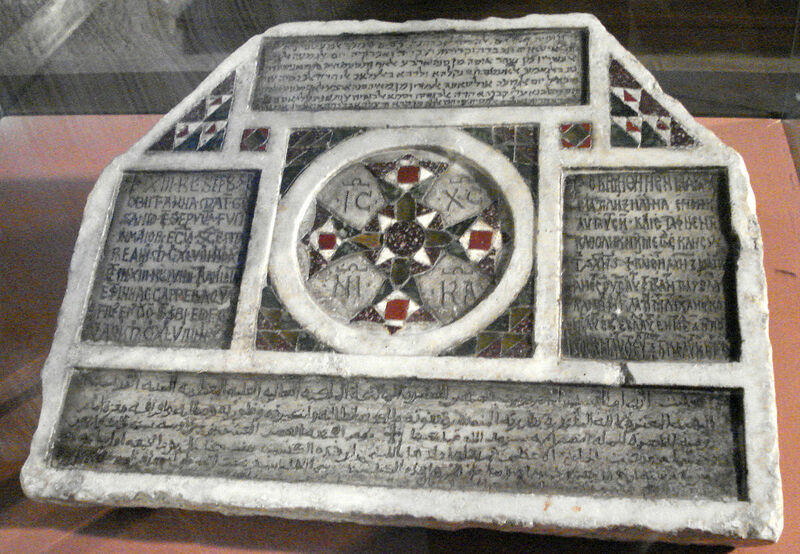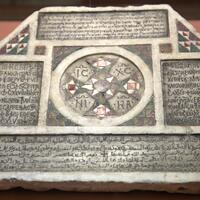Quadrilingual epitaph from Palermo
Type:
Grave markers
Date:
1149
Location or Findspot (Modern-Day Country):
Italy
Dimensions:
32 × 40 × 5 cm
Description:
This quadrilingual tombstone was one of five memorial inscriptions commissioned by Grisandus, a priest at the Cappella Palatina in Palermo, in memory of his deceased parents. It commemorates his mother, Anna, in Judeo-Arabic, Greek, Arabic, and Latin (clockwise from top). The last three were all used as administrative languages at the court of King Roger II (r. 1130–54), and while many bilingual texts and objects are known from Norman Sicily, trilingual artifacts are rare and no other extant work preserves four languages. The four languages represent the four religious communities of twelfth-century Palermo: Jews, Orthodox Christian, Roman-rite Christians, and Muslims.
The tombstone is made of marble inset with opus sectile and glass tesserae, echoing the materials used in the Cappella Palatina and other elite buildings in Palermo. At the center of the plaque is the Greek abbreviation for "Jesus Christ Conquers." Anna, who died in 1148, descended from a Byzantine family and probably spoke Greek; her husband, Drogo, was from western Europe. She was reburied in 1149 in a chapel (dedicated to St. Anna) founded by her son inside an Orthodox church. When Drogo died a few years later, he was buried alongside his wife and his grave was marked by a trilingual epitaph. The tombstones made for Grisandus were personal works that echoed the multicultural ideology of Norman Sicily under Roger II.
The tombstone is made of marble inset with opus sectile and glass tesserae, echoing the materials used in the Cappella Palatina and other elite buildings in Palermo. At the center of the plaque is the Greek abbreviation for "Jesus Christ Conquers." Anna, who died in 1148, descended from a Byzantine family and probably spoke Greek; her husband, Drogo, was from western Europe. She was reburied in 1149 in a chapel (dedicated to St. Anna) founded by her son inside an Orthodox church. When Drogo died a few years later, he was buried alongside his wife and his grave was marked by a trilingual epitaph. The tombstones made for Grisandus were personal works that echoed the multicultural ideology of Norman Sicily under Roger II.
Relevant Textbook Chapter(s):
7
Image Credits:
Wikimedia Commons, G.dallorto; Linda Safran


